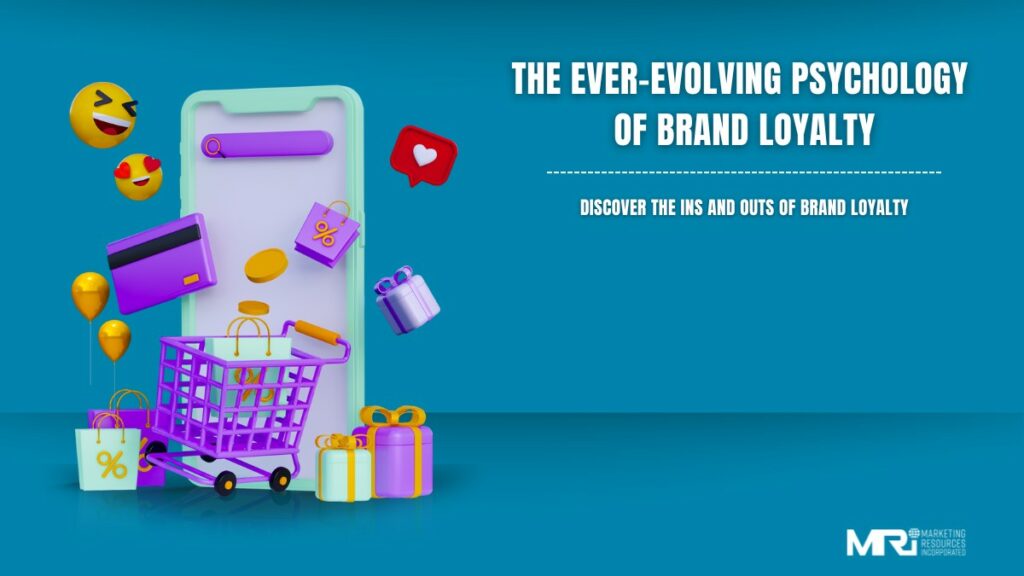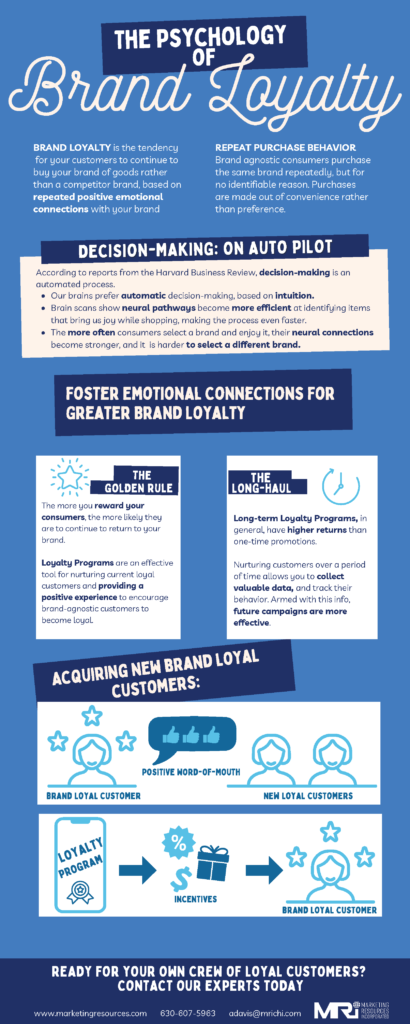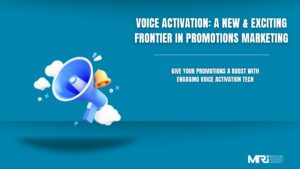The psychology of brand loyalty has baffled sales and marketing teams for decades. Over the years, we’ve gone from seeing headlines lauding customer loyalty as the gold standard of quality business and critical to its success, to being disregarded as a metric not even worth measuring. On one hand, we’re told that increasing customer retention by only 5% can increase revenue from 25-95%, according to one Harvard Business Review study, while other studies tell us that consumers (particularly younger consumers) couldn’t care less about loyalty. So, which is it?
Both.
The truth is, brand loyalty has evolved over the years as much as the consumers you serve, and your company is likely taking an outdated approach to achieve customer retention. Is it an important and valuable metric to strive for? Absolutely. Will it increase your revenue by nearly 100%? Probably not. The fact is though, brand loyal consumers are more likely to spend money and encourage others to spend theirs with your brand.
As a marketer, understanding brand loyalty in the context of your target market allows you to more effectively retain your ideal customers, increase positive associations with your brand, and yes, even increase revenue. Failing to foster loyalty can raise your acquisition costs, increase customer churn, and spread negative word-of-mouth.
What is Brand Loyalty?
Simply put, brand loyalty is the tendency for your customers to continue to buy your brand of goods rather than a competitor brand. For one reason or another, your customers are hooked on you. Unfortunately, nothing is ever that simple, especially in sales and marketing.
As previously mentioned, brand loyalty is fluid. It evolves in tandem with your customers. Take a moment to consider how your company has had to adapt to meet your customer’s changing needs and desires. As an example, with the continued rise of social media, consumers are increasingly purchasing products online directly from an app (like Instagram or TikTok). How might these consumers differ from those who enter a brick-and-mortar store or make a purchase on your website? Do they expect the same experience from your brand?
Therefore, in order to fully understand and reap the benefits of brand loyalty, you must first fully understand your customers. How do they interact with your brand? Online or in-person or perhaps both? What are their values? How do they make their decisions? Who are they?! Once you’ve tapped into your target audience, you can begin to foster customer loyalty.
Psychology of Brand Loyalty Versus Repeat Purchases
A consumer who buys your product over and over again is not automatically brand loyal. Yep, you read that correctly. Brand loyalty is earned and valuable. There’s a reason why a consumer continues to choose one brand over another.
With repeat purchases, there is no reason. Consumers are brand agnostic, heck, they might not even realize which brand they’re buying. Think of the most basic item consumers buy on a regular basis, something simple like eggs or milk will do. Why do they pick one carton over another? Eggs are just eggs after all.
But, consumers probably buy the same type of eggs over and over again. For me, it’s the same gray and blue carton for decades. Would I switch to a different carton? Sure, if I had to. Could I tell you why I buy the gray and blue carton each time I go to the store? I can’t even tell you the name of the brand, let alone why I’ve been buying it. This is an example of being a repeat buyer and not a brand loyal one.
Remember: the difference between brand loyalty and repeat purchases is that brand loyal consumers return to a particular brand due to an identifiable factor. Even if the product is more expensive or less functional, brand loyal consumers will continue to flock to it. Repeat purchase consumers on the other hand, simply buy products out of convenience.
The Study of Brand Loyalty
Now that we’re able to distinguish brand loyalty from repeat purchases, we can dive further into the psychology behind brand loyalty. How do our brains make decisions for us? What factors are we instantaneously analyzing (and how are we analyzing them) in the milliseconds it takes us to go from “hey, what’s this?” to “add to cart?”
The good news: this has been studied! So much! Literally, thousands of articles and reports exist claiming to demystify the human brain as it shops.
The bad news: there are literally thousands of differing opinions on brand loyalty. Some of them are good with a foundation in science and some of them are just.. opinions. We’ll help you figure out which is worthwhile.
A few things are for certain across the board, though. For example, it’s widely accepted that adding personalized elements to your loyalty campaigns is beneficial. In fact, one study found that over 80% of consumers are more likely to do business with a company or brand s that offers personalized experiences.
Further, by and large, consumers actually want to be loyal to a brand. They crave connections with their favorite brands and even want to interact with and trust them. This is evidenced by the fact that a whopping 91% of consumers are more willing to shop with brands that recognize and provide relevant offers to them, and 83% are willing to share their data to make this work.
The evidence is clear: consumers want brands to know who they are. They’re willing to share information about themselves with these brands in order to receive relevant recommendations and information, creating a more enjoyable experience for them. For more on developing relationships with loyal customers, check out our full article.
The Psychology of Decision Making
Keeping in mind that there are always outliers within any set of data, The Harvard Business Review reports that, much to our dismay, our brains are not as analytical as we once thought. Instead, in making purchasing decisions and in general, our brains prefer automaticity over conscious decision-making. We as individuals are much less responsible for the choices we make than we might think we are.
Our brains are overwhelmed, and not just because of the pandemic that was supposed to last two weeks that stuck around for two years (and counting..). Our brain processes and filters a whole world’s worth of stimuli, and there’s quite a bit of it. It could use a break but it probably won’t ever get one. To save itself some time and energy, our brains have become an expert at “filling in the gaps.” Taking incomplete information from stimuli, our brains instantly supplement it based on past experiences so we can quickly make a decision and move on.
Further, once our brain starts to automate the decision-making process, it becomes harder and harder to make it a manual process again. This evidence isn’t just anecdotal either. Brain scans show our neural pathways, the highway of our brain, become more efficient at identifying a product that brings us joy the more often we get joy from it. Every time we buy a Pepsi (and love it because Pepsi is delicious), it becomes harder for us to buy a Coke. The more positive experiences we have surrounding a brand, the more concrete those feelings become for us.
Really, all of that is to say that consumers are not consciously weighing their options and scratching their heads as they ponder which product to add to their cart. They’re not thinking to themselves “you know, I tried this brand a few weeks ago and it was pretty good.. But this other product looks good as well..” they’re looking at the product for a second or two and moving on to the next item. However, this does not mean that the decision-making is random. Just because our brains automatically make these calls for us, doesn’t mean we don’t have a reason for preferring one brand over the other. You can still be brand loyal without consciously being brand loyal.
Rather, our brains make informed decisions on our behalf. It’s just a little bit faster than we are. Our brains remember the consistent gratification that we get from the brands that we’re loyal to, and want us to experience it more and more. Building loyalty then becomes a system of behaviors and positive experiences, pushing people to move from the conscious decision to one that they don’t have to think about (or don’t want to think about).
Brand Loyalty in Practice
Let’s go back to the example before with Pepsi. Imagine you just stopped at a convenience store because you’re thirsty. You love Pepsi, you’ve been buying it for years. When a restaurant carries the competitor, you just ask for water. You. love. Pepsi. You walk in, grab a Pepsi (or two), walk out and take that first sweet sip all within less than a minute. Your intuition told you to buy a Pepsi.
Why didn’t you stop and read the label on every beverage in the store? You probably had hundreds of options but you (or rather, your brain) made your decision within a few seconds. You weren’t plagued by decision paralysis despite having more options than you know what to do with. Why? Because you’re brand loyal to Pepsi. You have at least one, maybe even a dozen, reasons you prefer Pepsi.
At one point, probably when you first experienced the brand, you had a positive association with it. It made you feel all good and tingly inside, and not just because of the carbonation, either. From then on, you kept having positive experiences with the brand. It kept tasting great, or maybe it was discounted or gave you a gift. Whatever the case, Pepsi won you over and continually worked to keep a hold on you.
Of course, you can try other sodas. Nobody is a robot and 100% predictable, 100% of the time. You might even venture into lemonades or slushies or something totally different. Even if you do like those other drinks though, you’ll almost always come home. That’s brand loyalty calling you home, and of course, you answer.
Clearly, the positive associations your brain attaches to a brand are what really drive your decision-making, and, ultimately, whether or not you’ll be brand loyal. Customer loyalty is built on a foundation of multiple positive emotions.
Sure, Pepsi is amazing but this scenario can be played out with any consumer and any brand that has attracted loyalty.
Nurturing Brand Loyalty
So far, brand loyalty seems pretty confusing. The line between brand loyalty and just being a repeat purchaser appears quite thin. And, as a company, you may find it difficult to distinguish between customers who are loyal and those who just happen to place your item in their cart. Imagine asking every consumer why they purchased your product (feel free to daydream about that for a minute or two. The rest of this blog will be waiting for you when you’re ready to come back to reality).
Thankfully, fostering brand loyalty doesn’t have to be as complicated as defining and identifying it. Focusing on the factors that tend to influence brand loyalty will, over time, foster a deep connection between your brand and the consumers who love it. When they do venture away from your brand or forget why they love it, small nudges or reminders can be more than enough to evangelize them again. Tactics like a unique loyalty program app or precisely targeted geofencing campaign make highly effective additions to a loyalty program.
Another Harvard Business Review study finds that rewarding your customers, particularly the most valuable ones, can have real, tangible benefits for your brand. Your most loyal customers are your most profitable ones, by far. How do you reward them, and who’s most valuable?
The Golden Rule
We recognize the challenges here, but being generous with your consumers can have a massive impact on brand loyalty. Think of the golden rule: treat others how you want to be treated! Want your consumers to spend some money? Spend some on them! Enter: Customer Loyalty Programs.
Not all customers are created equal. Some will try your brand out and love it, then tell everyone they know about it and even post online. Some will try your brand, love it, and never tell a soul. Now, imagine they spend the same exact amount of money on your brand, but you can only keep one. Clearly, the consumer who spreads positive word-of-mouth about your brand, encouraging others to buy in the process, provides more value to your company. We call them “brand evangelists.”
Who doesn’t want a superfan cheering your brand on every step of the way? For free? All customers are like gold, but these brand-loyal super fans are diamonds. Support them and reward them with exclusive campaigns or loyalty programs and they’ll only appreciate your brand more.
Thankfully, you can reward both customers. In fact, with a purpose-driven loyalty program, you can not only nurture current brand-loyal customers, bringing them back to your brand over and over again. But, you can also encourage brand-agnostic customers to join your loyalty program as well.
Identify your brand superfans early and reward them often to foster loyalty. Brands that do this well, like Pepsi with the Pepcoin loyalty program, are able to communicate with their VIP customers over an extended period of time and reward them accordingly. This keeps consumers coming back for more, thereby rewarding Pepsi as well. Given the choice between two drinks, one of them also gets you points (or actual cash, in the case of Pepcoin) towards a prize or incentive, and one of them doesn’t. That’s an easy choice for consumers to make, so easy in fact that they don’t even need to think about it.
In this For the Long-Haul
At its core, customer loyalty is a long-term process. It’s not developed overnight. A one-time promotion or giveaway, while effective, may have fewer returns on investment than a long-term loyalty program for a number of reasons.
While it may seem less expensive to implement up front, the costs (both explicit and opportunity costs) of a poorly run promotion are far more than those of a well-executed loyalty program.
Consider you’re tasked with increasing revenue. A quick, lead-generating promotional campaign might sound awesome. You decide to offer a huge gift to bring in hundreds, even thousands of potential customers. You choose to give away a car and you end up getting a bunch of leads. Of course, everyone wants a free car! What do those customers do after the car has been given away, though? Frankly, you have no idea, but chances are, they’ve moved on to another brand or another giveaway.
Instead, consider you decide to run a years-long program, like Foodland Super Market, which has been running the same loyalty program since 1995. The customers who are drawn to your brand, like the Foodland customers, are much more likely to stay with your brand, simply because they know they’re much more likely to continue to be rewarded.
What do these customers do? How do they interact with the brand? Just like Foodland, you will know exactly what they do! You can capture info on your customers, tracking them through the loyalty program.
The result? Foodland’s program is still wildly successful 26 years later. Their customers come back again and again. Some customers have been loyal for all 26 of those years. The value of that customer over their lifetime is far greater than the value of a customer who bought your product once in the hopes of winning big.
The Strategy Behind Your Brand Loyalty Program
With an understanding of the psychology behind decision-making and customer loyalty, your brand can tap into the deeper pockets of lifetime loyal customers. As part of any effective marketing strategy, customer loyalty programs are complex and should be handled with precise strategy.
With so much at stake, and so much to gain from properly nurturing loyal customers, leave the strategy in the capable hands of a trusted promotional partner. Marketing Resources Inc. has over 26 years of experience implementing and executing successful loyalty campaigns for some of the largest brands in the world. Yep, that Foodland loyalty program is one of ours, it even won an award in its first year.
We’ve been trusted by some of the largest brands in the world and time and time again, using our unique 4-step Big IDEA process, we’ve delivered on our promises, and then some. Our purpose-driven campaigns take a client from ideation, through the development and execution of a well-thought-out campaign. We go the extra mile to ensure each program we run addresses our clients’ needs and sets them up for future success.
Contact one of our experts today to begin planning your customer loyalty program.







